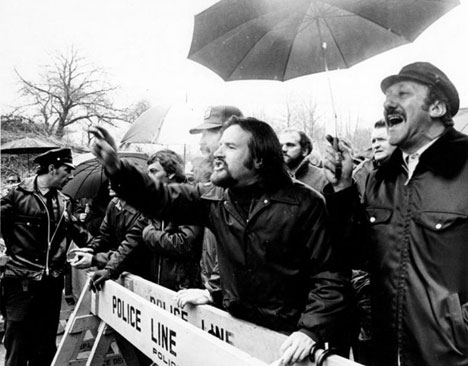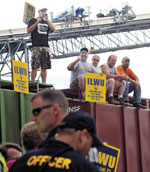
Showdown on West Coast Docks: The Battle of Longview
(November 2011).
click on photo for article
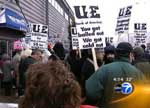
Chicago Plant Occupation Electrifies Labor
(December 2008).
click on photo for article
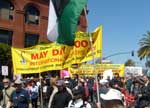
May Day Strike Against the War Shuts
Down
U.S. West Coast Ports
(May 2008)
click on photo for article
February 2013
Needed: A Class-Struggle Union Leadership
Fighting for a Workers Party
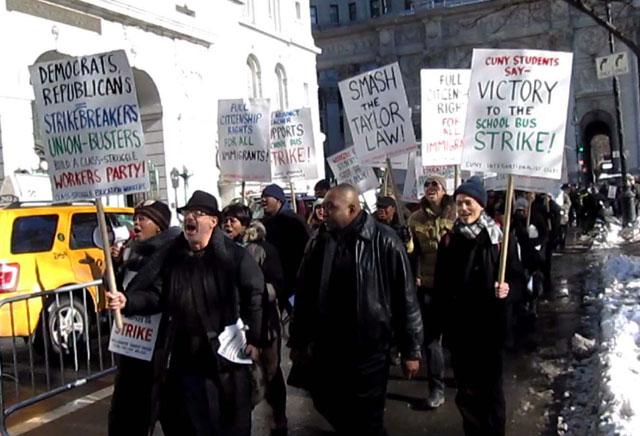
Internationalist contingent at February 10 “union unity” march over the Brooklyn Bridge. Thousands
of bus strikers marched, but the rest of labor was MIA. (Internationalist photo)
On Friday, February 15, the month-long strike by the 8,100 school bus drivers and matrons of Amalgamated Transit Union Local 1181 was called off by the union leadership. There was no vote by the membership, the decision was announced in a 45-minute teleconference call. The next day the labor-hating New York Post crowed, “Union Strike Bus-ted.” The liberal New York Times proclaimed the outcome a “Win for New York Mayor” Michael Bloomberg, who issued a statement gloating that “special interests,” which is how the capitalists and their politicians refer to unions, “have never had less power than they do today.” Racist right-wingers on the Internet blasted the largely black and Latino strikers as “greedy union thugs.”
Although relieved to be earning a paycheck again after weeks of watching bills pile up, many strikers were angry about being sent back to work with empty hands. ATU leaders said in “suspending” the strike they were honoring the request of the five Democratic mayoral candidates who signed a joint letter calling on workers to return to their jobs in exchange for a pledge to “revisit the school bus transportation system and contracts if elected.” (Four of the five call-off-the-strike Democrats were previously endorsed by the Working Families Party.) Local 1181 president Michael Cordiello said the letter gave him “great confidence” that the next mayor would be “far more sympathetic.” But many bus workers The Internationalist spoke with said they didn’t trust the Democrats one bit.
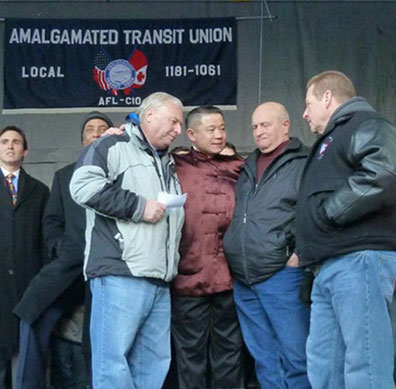 ATU 1181 leadership
with Democratic mayoral candidate John Liu
(center) at February 10 City Hall rally.
Looking to the Democrats, or any capitalist
party, is a ticket for defeat. (ATU Local 1181)
ATU 1181 leadership
with Democratic mayoral candidate John Liu
(center) at February 10 City Hall rally.
Looking to the Democrats, or any capitalist
party, is a ticket for defeat. (ATU Local 1181)
The candidates made sympathetic noises, but they pointedly did not pledge to uphold or restore the Employee Protection Provisions (EPPs), the central issue in the strike. Relying on the Democrats will not defend union gains – they represent the interests of Wall Street and corporate bosses no less than do the Republicans. Currently, Democratic president Obama is leading the union-busting attack on teachers, while New York Democratic governor Cuomo vetoed a bill that would have guaranteed EPPs. But in fact the letter was requested by the ATU International in order to give the union tops what amounted to a face-saving way to call off the strike. The ranks did not buckle, the leaders did. They had no program to win the battle, so they threw in the towel.
When they went back to work the following Wednesday, February 20, more than 300 strikers were told their jobs were gone. When we arrived at the Reliant yard on Zerega Avenue in the Bronx at 5:15 a.m. that morning, drivers and matrons were being refused entry by management, which said it had hired 120 “replacement workers,” or scabs. Cops (and even a couple of “white shirts”) had been called in against the angry workers, but eventually the union got the company to back off. In Red Hook, Joey Fazzia of Boro Wide announced the company had shut down and all hundred-plus matrons were out of a job. Most but not all are now back. However, citywide more than 100 strikers are still fired, particularly at Rainbow/All American in Astoria. The union’s response has been to threaten legal action for unfair labor practices.
The school bus strike was the biggest strike in New York City since the 2005 transit strike, which for three days brought traffic in Manhattan to a virtual standstill. The ATU strikers stuck it out in the bitter cold, in isolated areas of the city, for weeks. Picket lines stayed strong, and two-thirds of the bus routes were shut down (the other third were non-union or Teamsters Local 584, which shamefully did not go out). But the strikers could not by themselves shut down the schools or seriously affect commerce in the city – that required solidarity action by the rest of labor, the United Federation of Teachers first and foremost, and that didn’t happen. The UFT, Central Labor Council and the rest of labor officialdom left the strikers twisting in the wind.
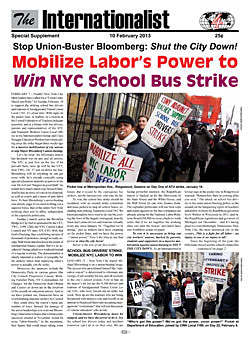
From the first day of the strike, we called in leaflets, on picket signs, and in a special tabloid strike supplement of The Internationalist, close to 3,000 copies of which were distributed to strikers, to “Mobilize Labor’s Power to Win NYC School Bus Strike.” But while 5,000+ ATU members came out for the February 10 march over the Brooklyn Bridge to City Hall, almost none of the rest of labor did. Delegations ranged from a handful to less than 50 for the UFT (with a membership of over 100,000 active school personnel in the city). As we noted, the march was deliberately held on a Sunday so it couldn’t possibly disrupt anything, and was addressed by a parade of Democratic politicians, who a few days later issued the requested back-to-work letter.
It was all part of Operation End the Strike. In the aftermath, a leaflet by Class Struggle Education Workers (“Who Knifed NYC School Bus Strikers in the Back?”) that was distributed to hundreds of returning strikers on February 16 stated: “It would have taken the combined determination of the whole NYC labor movement to break Bloomberg’s union-busting. But labor leaders didn’t ‘walk the walk,’ they barely mumbled the talk.” While “salut[ing] school bus drivers and matrons whose brave month-long strike inspired us all,” the CSEW leaflet warned that “Labor tops’ reliance on Democrats leads to defeats” and concluded: “Victory requires a new, class-struggle leadership and a workers party.”
The NYC school bus strike was a signal event for labor. Instead of just lying down and taking it, as so many unions have done, workers were fighting back. The defeat of the strike is a bitter pill for the workers to swallow. Yet while the battle was lost, the war is not over. For the union leadership, which was not prepared to wage class war – and didn’t even know how to when it had to – this is a meaningless cliché. For union militants, both in the ATU and elsewhere, it underlines the need to draw the lessons of this strike, in order to prepare a battle plan for victory in the future. The key for that is a struggle within the mass organizations of labor, the unions, for a revolutionary program to wage and win all-out class war, which is what we are facing.
Michael Bloomberg knows he is waging a war on labor, and he is prepared to go to the limit. He cynically used special needs children as pawns, reveling in the hardship families were facing, in order to blame the union. Luckily most parents weren’t taken in by the lies of the haughty billionaire mayor, who during Hurricane Sandy told New Yorkers to kick back and watch TV (no so easy when you have no power). Bloomberg represents the enemy, the Wall Street financiers and corporate moguls who live off the wealth that working people produce. The obstacle we face in fighting them is the labor misleaders, who religiously follow the capitalist laws and support the capitalist parties. They’re playing softball when Bloomberg & Co. are playing hardball. But as history has shown over and over, if you play by the bosses’ rules you’re sure to lose.
V.I. Lenin referred to strikes as a “school of war,” class war. So what are the lessons to be learned here? First of all, said the Russian revolutionary leader, “a strike teaches workers to understand what the strength of the employers and what the strength of the workers consists in.” Bloomberg and his class have all the money, obviously, but it is the workers who make the system run. Second, a strike “opens the eyes of the workers to the nature, not only of the capitalists, but of the government and the laws as well.” So in the school bus strike we not only saw the police penning in strikers, we saw the mayor lying about a 2011 court decision, calling the strike illegal, and then blithely ignoring an NLRB ruling that the strike was legal. For the bosses, “the law” is just an instrument of their class rule.
To win, it was necessary to understand that this was no isolated strike. School bus workers were up against a concerted union-busting drive by the capitalist rulers nationally and internationally. It was not just over dollars and cents, at stake were workers’ jobs. If Bloomberg wins, bus drivers’ pay will likely be cut in half (to the starting wage of $14.50 an hour), hours reduced to part-time (as is already the case for ATU 1181 members on Long Island) and everyone’s benefits slashed to the bone. It’s impossible to get by on that, much less retire with dignity, in this most expensive city in the U.S. It’s not just that the bosses are “destroying the middle class,” as the labor tops say. The war on the unions aims at impoverishing all workers. This is a battle for survival.
The
bus drivers and matrons were ready and willing to
fight. Even a day before the strike was called
off, hundreds turned out to jeer the mayor at his
“state of the city” speech at the Barclay Center
in Brooklyn. But the union leaders went about it
as if this was the same old same old. They begged
Bloomberg to join the talks, to delay bids on bus
routes, they offered to help cut costs, they
sought support from “elected officials,” they
asked for mediation, to no avail. They made no
attempt to stop scab buses or to picket out the
Teamster Local 584 companies. OMG, that would be a
“secondary boycott” under the slave-labor
Taft-Hartley law, which they wouldn’t dare defy.
Above all, they didn’t seek solidarity action by
teachers, students, parents, transit workers and
all NYC unions to shut the city
down. That is what it would take to win.
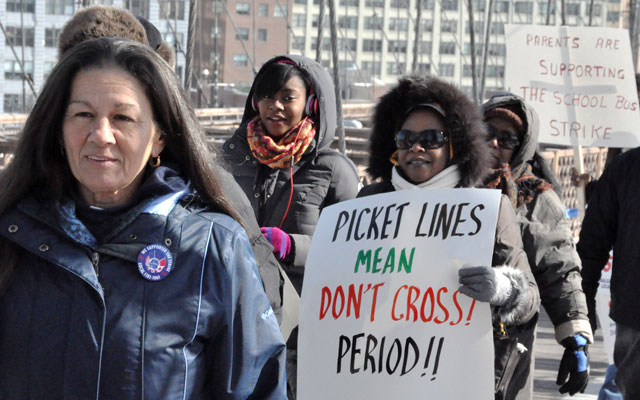
ATU strikers march
across Brooklyn Bridge, February 10. (Photo: Michael Fleshman)
In the face of this severe setback, there will inevitably be some demoralization among strikers who fought hard and have nothing to show for it. Union militants know that things would be even worse if they hadn’t fought, and workers gained a lot of experience during the strike, the first by NYC school bus workers since 1979 . But in order to prevail in the next time around, the key is leadership. The present local leaders are mostly the continuation of the previous regime that the feds went after for mob ties. There have been opposition groups in 1181 before, such as Members for Change, which won several positions and almost took the local presidency in 2009, backed by many Haitian and Hispanic drivers and matrons who make up 70 percent of the membership.
But
a more representative leadership running on a
program of union democracy will not therefore be
sufficient to defeat a powerful opponent in a
knock-down, drag-out fight. In fact, groups like
the “Association for Union Democracy” have played
a sinister role over the years by tying union
opposition groups to the bosses’
government, far and away the biggest enemy
of the working class. The key lesson of the strike
is the need to build a class-struggle leadership
to fight for total independence from the
capitalist state and the capitalist parties. So
long as labor is tied to the Democrats, it is
bound to lose. We need a fighting workers party,
and we need it now. It’s up to us, to those
working people and our class allies among the
oppressed who have drawn the lessons of past
defeats, to lead the way.
|
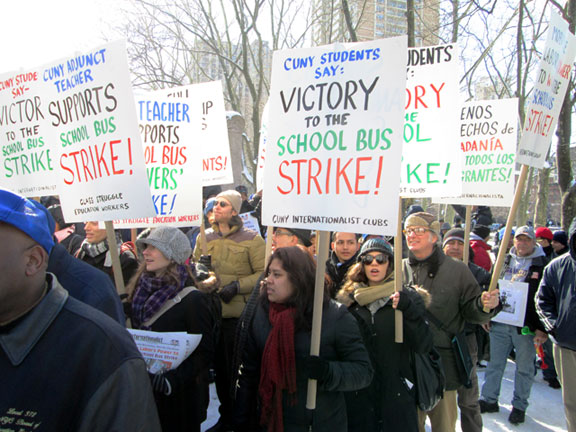 The NYC school bus strike was also a test for the left which claims to support the cause of labor. The Internationalist Group, Class Struggle Education Workers and CUNY Internationalist Clubs were active in support of the strikers from the start. We leafleted and went in groups to picket lines almost daily in Brooklyn, Queens and the Bronx. The CSEW held a forum on the strike in late January where striking drivers and affected parents spoke along with representatives of ATU Local 1181, TWU Local 100 and the IG. We distributed thousands of copies of a strike supplement to The Internationalist and marched in a contingent over the Brooklyn Bridge on February 10. Our focus throughout was on mobilizing the power of NYC workers in action, because it was clear from the outset that bus drivers and matrons couldn’t win on their own. For the most part, however, not only did NYC unions not bring out their hundreds of thousands of members, most socialist groups were also AWOL, nowhere to be seen. Teachers were the most directly affected by the strike, and the UFT leadership predictably cold-shouldered the strikers, despite repeated efforts by a delegate who is active in the CSEW to get the union to act. But the reformist opposition inside the UFT also did next to nothing. The International Socialist Organization published an account, “A Bitter Setback for NYC School Bus Drivers” (Socialist Worker, 19 February), which was breathtaking in its sheer arrogance. The article stated, “It’s unfortunate that Local 1181 didn’t reach out to the Movement Of Rank-and-file Educators (MORE) within the UFT.” A typical response of would-be bureaucrats: We didn’t do anything because no one asked us to. But on top of the arrogance we get mendacity, which is a fancy word for lying. The article states: “MORE was eventually able to push the UFT to publicly support the bus workers in the strike’s waning days....” Nonsense. MORE didn’t put the heat on the UFT tops. Some phone calls to UFT officials don’t amount to anything (we did that too, but also went to the executive board and put forward a motion in the delegate assembly calling for a mass rally). Aside from a token presence of a few caucus members who acted honorably, MORE was MIA. Barely a handful of its supporters showed up at the February 10 march, and in the one case where MORE put out a call to join the picket line at the DOE, almost none of them even bothered to show up. The Progressive Labor Party, to its credit, did show up on the picket lines with some students on several occasions. Naturally, PL did it in their Stalinist fashion, ordering students not to take copies of The Internationalist and making them give them back. Challenge (13 February) also crudely removed “Internationalist Group” from a sign in its front page photo. You can’t teach old Stalnists new tricks. Even as Challenge poses as a “revolutionary communist” newspaper, it has nothing in common with Lenin’s Pravda, which means “truth.” PL’s opportunist twists and turns can be mind-boggling, calling to “actively participate in Obama’s campaign” only to turn around and label his policies “fascism.” They figure no one will remember. Workers World Party’s intervention in the strike was mainly in supporting Parents to Improve School Transportation (PIST), and bringing supporters from the Boston school bus drivers union (USW Local 8751) to a February 2 caravan and rally at Zerega Avenue in the Bronx. A wrap-up article, “Lessons of the NYC school bus strike: Was it worth it?” (Workers World, 7 March) is basically an apology for the ATU leadership, with a pro forma criticism of the Democrats, saying that the whole experience “lays the basis for the next stage of the struggle.” This kind of sugar-coating can only disorient strikers who are seeking to lay the basis for winning next time by understanding what went wrong this time. On the other hand, the World Socialist Web Site of the Socialist Equality Party positively encourages and feeds on demoralization as a result of the defeat of the strike. The SEP is a dubious outfit of anti-union, reformist political bandits. Dubious, because its main leader is the owner of a non-union (scab) printing plant in Michigan. Anti-union, because they actively try to get workers to leave unions, and side with employers in telling workers not to vote for unions in representation elections. Reformists because they pretend that that the aim of a workers government should be “ending the rule of the financial oligarchy and the reorganization of economic life to meet human needs, not private profit” (WSWS, 18 February). What’s needed is not simply “reorganizing economic life” to sideline the bankers but a socialist revolution. The SEP writes (WSWS, 23 February) that in this strike, “The union itself was fighting for interests that were separate and hostile to those of ordinary workers.” This is a fundamental falsehood. Like the media and the union leaders themselves, they equate the union with the bureaucracy that sits atop it and feeds off it. Yet the basis of the union is the membership, and the ranks of drivers and matrons were out there on the picket line desperately fighting for their interests. When they chanted “ATU 1181” they were referring to themselves. The union tops reflected different interests and a different agenda not in calling the strike but in calling it off. The labor
bureaucracy, what American socialist
Daniel DeLeon called the “labor
lieutenants of the capitalist class,” is
a contradictory layer that seeks to act
as a buffer between the bosses and the
workers. They support the capitalist
parties and imperialist wars. The
bureaucrats are an obstacle
to workers’ struggle, which must be
swept out in order to win; the bosses
are the enemy.
Failing to understand this crucial
difference would spell defeat for
workers. The task that faces us is not
to get rid of the unions, but to oust
the bureaucrats, break with the
Democrats and all capitalist parties,
and build a class-struggle leadership
fighting for a workers party on a
program for a genuine workers government
that can put an end to the capitalist
system of war, racism and poverty and
open the road to a socialist society of
abundance for all. |
See also:
Class Struggle Education Workers: Who Knifed NYC School Bus Strikers in the Back? (22 February 2013)
Mobilize Labor's Power to Win NYC School Bus Strike (7 February 2013)
Bust Bloomberg Union-Busting! (2 February 2013)
School Bus Drivers’ Strike: Mobilize NYC Labor to Win! (21 January 2013)
Class Struggle Education Workers: Bring Out NYC Labor to Support School Bus Drivers Strike (20 January 2013)
Internationalist video: Scenes from the NYC School Bus Drivers Strike, January 2013 (24 January 2013)
To contact the Internationalist Group and the League for the Fourth International, send e-mail to: internationalistgroup@msn.com
